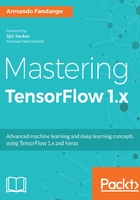
上QQ阅读APP看书,第一时间看更新
TensorBoard details
TensorBoard works by reading log files generated by TensorFlow. Thus, we need to modify the programming model defined here to incorporate additional operation nodes that would produce the information in the logs that we want to visualize using TensorBoard. The programming model or the flow of programs with TensorBoard can be generally stated as follows:
- Create the computational graph as usual.
- Create summary nodes. Attach summary operations from the tf.summary package to the nodes that output the values that you wish to collect and analyze.
- Run the summary nodes along with running your model nodes. Generally, you would use the convenience function, tf.summary.merge_all(), to merge all the summary nodes into one summary node. Then executing this merged node would basically execute all the summary nodes. The merged summary node produces a serialized Summary ProtocolBuffers object containing the union of all the summaries.
- Write the event logs to disk by passing the Summary ProtocolBuffers object to a tf.summary.FileWriter object.
- Start TensorBoard and analyze the visualized data.
In this section, we did not create summary nodes but used TensorBoard in a very simple way. We will cover the advanced usage of TensorBoard later in this book.